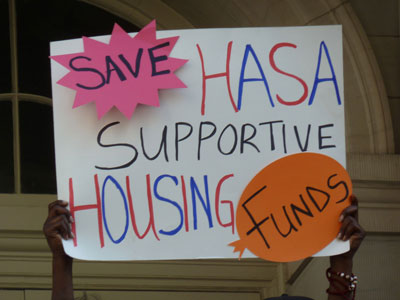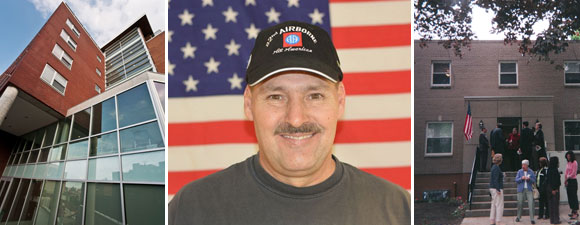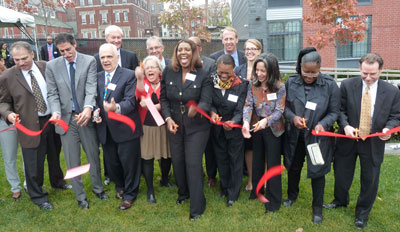

Showing Posts by Date: 11/2013
11.22.2013
 We are delighted to announce that, as part of his final budget modification yesterday, Mayor Bloomberg fully restored all cuts to HIV/AIDS Services Administration (HASA) supportive housing contracts.
We are delighted to announce that, as part of his final budget modification yesterday, Mayor Bloomberg fully restored all cuts to HIV/AIDS Services Administration (HASA) supportive housing contracts.
Five years ago, Mayor Bloomberg proposed cutting HIV/AIDS supportive housing contracts by $1.876 million. In subsequent years, he increased that cut to $5.1 million. Each year, the Network’s staff and members fought vociferously alongside VOCAL, Housing Works, the Momentum Project and other advocates to convince the City Council to restore the funding. Thanks to the leadership of Speaker Christine Quinn and General Welfare Chairs Annabel Palma and then-Council Member Bill de Blasio, the funding was restored each of the past five years. Each year, however, the administration failed to restore this funding to what’s known as “the baseline budget” for permanent restoration. Yesterday, Mayor Bloomberg did just that. In short: The annual HASA budget dance is no more.
The Network staff wants to thank all the members, tenants and advocacy partners who came out year after year for rallies, press conferences, meetings and testimony. We also want to thank Mayor Bloomberg for making this permanent restoration and applaud his efforts to leave Mayor-elect de Blasio with a balanced budget.
For more information on this multi-year budget battle, visit here.
To see Mayor Bloomberg’s press release and budget documents visit, here and here (p.29).
11.20.2013
 A new report on youth homelessness offers insights on the plight of young adults living on the street in New York City.
A new report on youth homelessness offers insights on the plight of young adults living on the street in New York City.
Yesterday, the New York City Coalition on the Continuum of Care (NYC CCoC) released a report on the results of a 2013 survey of unaccompanied NYC homeless youth. The report synthesizes the results of a 27-question survey administered to homeless young adults on the night of January 28, 2013.
Among its startling findings, A Count of Unaccompanied Homeless Youths in New York City reveals that the median duration of homelessness for these young adults is 730 days, or roughly two years. You can read the entire report here. For a quick summary of its findings, see this handout.
The report was commissioned by the CCoC’s Youth Committee, a body co-chaired by the Network and the Ali Forney Center. The report reveals a number of distressing traits about those surveyed:
11.14.2013
![]() Reminder: The NYS Office of Temporary and Disability Assistance (OTDA) has $13.2 million still available to fund supportive housing projects through its Medicaid Redesign Team Homeless Housing and Assistance Program (MRT HHAP). This program, like the original HHAP program, provides grants and loans to acquire, construct and rehabilitate housing for persons who are or would otherwise be homeless. You can read the recently-updated Request for Proposals (RFP) here.
Reminder: The NYS Office of Temporary and Disability Assistance (OTDA) has $13.2 million still available to fund supportive housing projects through its Medicaid Redesign Team Homeless Housing and Assistance Program (MRT HHAP). This program, like the original HHAP program, provides grants and loans to acquire, construct and rehabilitate housing for persons who are or would otherwise be homeless. You can read the recently-updated Request for Proposals (RFP) here.
Projects eligible for MRT HHAP funds must provide permanent supportive housing to homeless single individuals. Tenants must also exhibit conditions or histories recognized to be associated with high Medicaid usage and be located in the Upstate and suburban metropolitan regions of New York. Examples of eligible populations include, but are not limited to, people who have experienced chronic homelessness, physical disability, mental illness, substance abuse and/or other disabling conditions.
OTDA’s Homeless Housing and Assistance Corporation (HHAC) will determine a project’s eligibility for this funding. Factors such as the population served, the support services offered and the location of the residence will determine eligibility.
Nonprofit organizations and their charitable organizations, municipalities and public housing authorities are eligible for this funding. This is an open-ended RFP, meaning OTDA will accept proposals on a continuous basis until funds are no longer available or this methodology no longer serves a purpose for HHAC.
Continue Reading … | New York State11.11.2013

(left to right) Jericho Project's Kingsbridge Terrace, a supportive housing residence for veterans in the Bronx; a tenant at The Knickerbocker, a transitional residence for vets from Services for the UnderServed (SUS); and the crowd outside the grand opening of the Richard J. Conners Veterans Home, a supportive housing residence from Albany Housing Coalition. Tenant photo courtesy of SUS.
On this Veterans Day, we wish to discuss the national tragedy of veteran homelessness.
In an era of fierce partisanship in Washington, D.C., ending homelessness among veterans remains one of the few issues both Democrats and Republicans can support. The Obama administration hopes to end veteran homelessness for good by the end of 2015. The administration, and the country, has a long way to go: According to the most recent estimates, nearly 63,000 homeless individuals identify as veterans in the United States. More than 6,000 of these men and women live in New York State.
New York nonprofits have taken a vigorous approach to lowering these numbers. Our state saw a 14% decrease in veteran homelessness from 2011 to 2012. We can attribute much of this drop to increased funding for Veterans Affairs Supportive Housing (VASH) vouchers and the work of our more than 220 supportive housing providers in New York.
Jericho Project offers a great example of how supportive housing nonprofits have helped end homelessness among veterans. An innovator in this field, Jericho launched a program last month to provide services to vets at risk of long-term homelessness.
This new program enables Jericho, for the first time, to provide homelessness prevention and rapid re-housing services to at-risk veterans and their families. Jericho offers assistance through case management, help with increasing income and direct cash assistance. The organization aims to serve 225 veterans this year. This new program is just one component of Jericho’s larger Veterans Initiative, which includes two supportive housing residences for vets.
“Jericho Project launched its Veterans Initiative in 2006 to address the specific needs of homeless veterans, with the recognition that veterans often do better when they are part of a supportive community of other veterans,” said Jericho Project Executive Director Tori Lyon. “Our goal is to help chronically homeless veterans heal and thrive while also preventing another generation of veterans falling into homelessness.”
Continue Reading … | Member News11.06.2013
.jpg) News outlets have begun to take notice of New York’s housing revolution. Last year, our state became the first in the nation to fund supportive housing as a means of lowering Medicaid expenses. New York did so through the Medicaid Redesign Team (MRT) Supportive Housing Initiative, a transformative program that represents the largest new funding stream for supportive housing in New York since the 2005 New York/New York III Agreement. The initiative commits a minimum of $75 million a year for three years to create supportive housing for high-cost Medicaid recipients.
News outlets have begun to take notice of New York’s housing revolution. Last year, our state became the first in the nation to fund supportive housing as a means of lowering Medicaid expenses. New York did so through the Medicaid Redesign Team (MRT) Supportive Housing Initiative, a transformative program that represents the largest new funding stream for supportive housing in New York since the 2005 New York/New York III Agreement. The initiative commits a minimum of $75 million a year for three years to create supportive housing for high-cost Medicaid recipients.
To date, New York State has provided over $46 million in capital to fund 483 supportive housing units in 12 buildings.
NY1 was the most recent news outlet to cover this story. Earlier this week, the station ran the below profile of Boston Road, a soon-to-be supportive housing development that received MRT funding.
Continue Reading … | Press11.06.2013
 The Washington Post ran a wonderful piece over the weekend on the benefits of supportive housing for tenants and taxpayers.
The Washington Post ran a wonderful piece over the weekend on the benefits of supportive housing for tenants and taxpayers.
The story, published in the paper’s Wonkblog, highlights the social and financial impacts of supportive housing in Chicago. It tells the story of two particular tenants to reveal a larger truth: that supportive housing can drastically reduce a homeless person’s dependence on costly emergency services. With a modest home and proper supports, these individuals can find stability and, in turn, rely far less on taxpayer-funded systems.
University of Chicago Professor Harold Pollack, who wrote the piece, puts it quite nicely: “It’s hard to care for yourself when you have no place to sleep, when you lack a refrigerator for your diabetes medicines, when you have no private space to regroup as you experience whatever you are dealing with.”
Professor Pollack lays out both the humane and the fiscal arguments for our housing model. On the fiscal side, he cites this seminal 2009 study, which found that supportive housing reduces hospital, emergency room and nursing home visits among formerly homeless individuals.
He also quotes Arturo Bendixen of the AIDS Foundation of Chicago. Mr. Bendixen presented his findings on supportive housing and cost savings earlier this year at the Network’s 13th Annual New York State Supportive Housing Conference. You’ll find video of his presentation below. Click here to view his PowerPoint slides.
Continue Reading … | Press11.01.2013
 More than 200 people gathered on October 31 to celebrate the development of Navy Green, a massive new mixed-income, market rate and supportive housing development in the Brooklyn neighborhood of Wallabout.
More than 200 people gathered on October 31 to celebrate the development of Navy Green, a massive new mixed-income, market rate and supportive housing development in the Brooklyn neighborhood of Wallabout.
The event marked the end of the first phase of development. This initial phase includes two mixed-income multifamily buildings and a 97-unit supportive housing residence. Once completed, Navy Green will enliven an entire city block with five residences and an expansive courtyard and garden. The final project will include a diverse mix of housing types and income levels, from market-rate townhouses to supportive housing for formerly homeless individuals.
The supportive housing residence, 40 Vanderbilt Ave., houses 59 formerly homeless and 38 low-income individuals. The formerly homeless tenants are all housed through funding from the NY/NY III Agreement.
Thursday’s ribbon-cutting was a who’s-who of New York supportive housing. Martin Dunn of Dunn Development Corporation and Deb Howard of Pratt Area Community Council served as the masters of ceremonies for the morning event. The two welcomed the crowd and introduced an impressive slate of guest speakers. Both hosts stressed the public-private-nonprofit partnership that helped make Navy Green a reality and the historic nature of the building site, which had previously been abandoned.
Continue Reading … | New York City, Openings